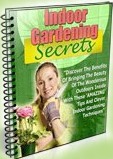Archive for the ‘General Gardening Tips’ Category
 CRYSTAL GARDENING WATER
CRYSTAL GARDENING WATER
One of the biggest challenges in water gardening is keeping the water almost as clear as crystal. Gardening water that is actually crystal clear probably has chemical or mineral pollutants in it. Ideally the water should be slightly brown or green.
When you first fill your pond with a hose, you will have the crystal gardening water you don’t want. Call your local water authority and find out what chemicals are in the municipal water supply. Allowing the crystal gardening water that comes from your tap to stand for a few days will let most of the chlorine dissipate. But you need chemicals to treat chlorine dioxide and chloramines. Pond supply dealers, garden suppliers and pet stores have kits you can use to test your crystal gardening water for unwanted substances. The dealers in those stores can advise you on treatment. Do not, however, use chemicals unless it is absolutely necessary. Do not put your plants and fish into crystal clear gardening water until after you have removed the chloramines.
Once you are rid of the unwanted substances, introduce the plants. They will begin the job of producing the food and oxygen that fish and other aquatic animals will need. They will also prevent the build-up of algae. The water will turn green, but it will clear up in a few weeks as the plants establish themselves. Then you will have the almost crystal gardening water that is the best habitat for your plants and fish. Now you can introduce fish, snails, and whatever other pond dwellers you wish.
It is natural for your water garden to have some algae in it. The mossy algae that grow on the side of the pond are actually beneficial, as they remove toxins from the water. But algae must not be allowed to grow unchecked. If they do, they will starve submerged plants by depriving them of nutrients. This in turn will deprive fish and other aquatic animals of oxygen, and they will die. Algae growth also makes your pond look unattractive.
You can control the growth of algae by putting in water lilies and other floating plants. They consume the nutrients that algae live on, and block out the sunlight algae require for growth. Snails and some fish help by eating algae.
If at all possible, keep algae growth under control by those natural means. You can also skim algae off the surface with a fine mesh net, a brush or a rake. It can also help to install one or two filters. If you must use chemicals, remember that is only a temporary solution, and one that could be harmful to your plants and fish.
 CONTAINER WATER GARDENING
CONTAINER WATER GARDENING
It is not absolutely essential that you have a natural pond or even an artificial pool in the ground in order to enjoy a water garden. Container water gardening is one of the easiest and most inexpensive ways for you to try your hand at this form of horticulture. Any container that can be used to hold water has potential for container water gardening. People have done wonderful things with old horse troughs, halves of distillery barrels, decorative fiberglass tanks, large cooking kettles, antique bathtubs and laundry tubs, and even children’s wading pools; turning otherwise drab corners and spaces into lush gardens. You can use just one pot or tub for container water gardening, or you can use several, with a variety of plants to make your garden all the more interesting.
Your container should be at least eighteen inches in diameter, but two feet is preferable. Where you place the container is very important. Of course, you want the container in a location where you can get the most enjoyment from it, such as on a patio or deck. But because the water in your container will heat up much more quickly than water in a pool in the ground, you must put the container in a place where it will be protected by shade during the hottest part of the day.
With container water gardening you have to be aware of stagnation and evaporation. You must top up the water frequently. It will also be necessary for you to regularly remove old water and replace it with fresh. Be sure you know just how you will drain or pump out the container and then refill it. Sometimes people forget to have the container within reach of a hose, resulting in some heavy lifting or frequent trips with a water bucket. If there are fish in the container, have a place to put them while you replace the water. This is also a good time to clean away any scummy build-up.
It is a good idea to line your container. Water gardening of this type obviously invites rusting and leakage. The material the container is made of might also contain substances that could be harmful to plants or fish. You can buy fiberglass shells that are specially made to line half-barrels. You can use PVC lining for other containers.
Any container of standing water is a potential breeding ground for mosquitoes. Goldfish or other species that feed on mosquito larvae will help keep your container free of this problem. If you live in a cold climate you will have to put the fish in an indoor aquarium during the winter.
